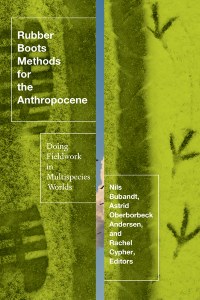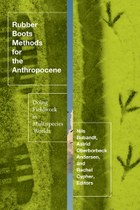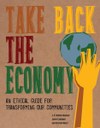Rubber Boots Methods for the Anthropocene
Doing Fieldwork in Multispecies Worlds
Nils Bubandt, Astrid Oberborbeck Andersen, and Rachel Cypher, Editors

Answering methodological challenges posed by the Anthropocene, this collection retools the empirical study of the socioecological chaos of the contemporary moment across the arts, human science, and natural science. The methodological companion to Arts of Living on a Damaged Planet, it provides empirical studies of the multispecies messiness of contemporary life that investigate some of the critical questions of our time.
From snorkel fins to worn sneakers, drip torches, boats, dogsleds, and the hooves of a horse, Rubber Boots Methods for the Anthropocene is a bold essay collection that pays attention to the ambulatory prosthetics that we wear or carry into particular fields (ocean, forest, savannah, university) and their many histories—material, colonial, multispecies. Situated knowledge has found its footing.
Melody Jue, author of Wild Blue Media: Thinking Through Seawater
The environmental and climatic crises of our time are fundamentally multispecies crises. And the Anthropocene, a time of “human-made” disruptions on a planetary scale, is a disruption of the fabric of life as a whole. The contributors to Rubber Boots Methods for the Anthropocene argue that understanding the multispecies nature of these disruptions requires multispecies methods.
Answering methodological challenges posed by the Anthropocene, Rubber Boots Methods for the Anthropocene retools the empirical study of the socioecological chaos of the contemporary moment across the arts, human science, and natural science. Based on critical landscape history, multispecies curiosity, and collaboration across disciplines and knowledge systems, the volume presents thirteen transdisciplinary accounts of practical methodological experimentation, highlighting diverse settings ranging from the High Arctic to the deserts of southern Africa and from the pampas of Argentina to the coral reefs of the Western Pacific, always insisting on the importance of firsthand, “rubber boots” immersion in the field.
The methodological companion to Arts of Living on a Damaged Planet: Ghosts and Monsters of the Anthropocene (Minnesota, 2017), this collection puts forth empirical studies of the multispecies messiness of contemporary life that investigate critical contemporary questions.
Contributors: Filippo Bertoni, Museum für Naturkunde, Berlin; Harshavardhan Bhat, U of Westminster; Nathalia Brichet, U of Copenhagen; Janne Flora, Aarhus U, Denmark; Natalie Forssman, U of British Columbia; Peter Funch, Aarhus U; Kirsten Hastrup, U of Copenhagen; Colin Hoag, Smith College; Joseph Klein, U of California, Santa Cruz; Andrew S. Mathews, U of California, Santa Cruz; Daniel Münster, U of Oslo; Ursula Münster, U of Oslo; Jon Rasmus Nyquist, U of Oslo; Katy Overstreet, U of Copenhagen; Pierre du Plessis, U of Oslo; Meredith Root-Bernstein; Heather Anne Swanson, Aarhus U; Anna Tsing, U of California, Santa Cruz; Stine Vestbo.
Cover alt text: Image of green, grunged ground with dark animal (likely bird) tracks moving vertically on left side and dark human shoe tracks moving vertically on right side. Image has thin split down vertical center with blue sky and, toward bottom third, small white cloud and several flying birds.
$34.95 paper ISBN 978-1-5179-1165-2
$140.00 cloth ISBN 978-1-5179-1164-5
432 pages, 57 b&w photos, 6 x 9, March 2023

Nils Bubandt is professor of anthropology at Aarhus University in Denmark. He is author of The Empty Seashell: Witchcraft and Doubt on an Indonesian Island and coeditor of Arts of Living on a Damaged Planet (Minnesota, 2017) and Philosophy on Fieldwork: Case Studies in Anthropological Analysis.
Astrid Oberborbeck Andersen is associate professor of techno-anthropology at Aalborg University, Denmark. She is coeditor of Anthropology Inside Out: Fieldworkers Taking Note.
Rachel Cypher is a postdoctoral fellow at the University of Pennsylvania's Penn Program in Environmental Humanities.

From snorkel fins to worn sneakers, drip torches, boats, dogsleds, and the hooves of a horse, Rubber Boots Methods for the Anthropocene is a bold essay collection that pays attention to the ambulatory prosthetics that we wear or carry into particular fields (ocean, forest, savannah, university) and their many histories—material, colonial, multispecies. Situated knowledge has found its footing.
Melody Jue, author of Wild Blue Media: Thinking Through Seawater
Explicitly cross-disciplinary, [Rubber Boots Methods for the Anthropocene] will be of wide interest to colleges and universities with larger libraries.
CHOICE
Where [Rubber Boots Methods for the Anthropocene] really shines—and offers something new—is in its ethical and political imperative to develop novel methodologies to understand our current moment.
H-Net Reviews

Contents
Acknowledgments
Introduction. Rubber Boots Methods: Outline for a Multispecies Study of the Anthropocene
Nils Bubandt, Astrid Oberborbeck Andersen, and Rachel Cypher
Part I. Critical Description
1. Walking in Italian Forests and Telling Stories about Global Environmental Change
Andrew S. Mathews
2. Interpreting Dwarf Shrub Patterns in the Lesotho Highlands
Colin Hoag
3. Tracking as Method: Perspectival Sensibilities in a More-than-Human Desert of Tracks
Pierre du Plessis
4. Plants of Internal Colonization: Critical Descriptions of Agrarian Change through Plant Agencies in South India
Daniel Münster
Part II. Curiosity
5. Drip Torch Inquiries: Meta-Questions for Ambiguous Forests
Jon Rasmus Nyquist
6. Tidalectic Ethnography: Snorkeling the Coral Reefs of the Anthropocene
Nils Bubandt
7. Stickiness in a Monsoon Air Methodology
Harshavardhan Bhat
8. Cattle Tracks in the Dust: Riding the Margins of the Anthropocene in the Pampas of Argentina
Rachel Cypher
Part III. Collaboration
9. Marine Hitchhikers and Nested Holobionts: Is the Aquarium Trade Creating Weedy Sponge Invaders?
Joseph Klein, Stine Vestbo, Peter Funch, and Anna Tsing
10. Anthropological Sensations: A High Arctic Travelogue
Kirsten Hastrup, Janne Flora, and Astrid Oberborbeck Andersen
11. Becoming Disturbed in Disturbing Landscapes: Methodology and Epistemology in Anthropocene Wastelands
Meredith Root-Bernstein, Filippo Bertoni, Natalie Forssman, and Katy Overstreet
12. Cholera, Common Ground, and Project Drafts: Messages in a Bottle
Nathalia Brichet
13. Rubber Boots Methods beyond the Field: Transformative Possibilities and Institutional Barriers in University Contexts
Heather Anne Swanson
Afterword. Troubling Methods in the Anthropocene: A Roundtable Discussion
Kirsten Hastrup, Ursula Münster, Anna Tsing, and Nils Bubandt
Contributors
Index

















